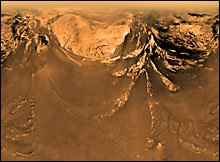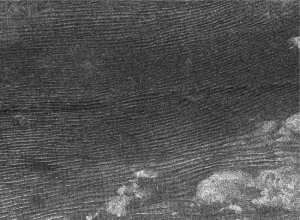
Movie Time
You can now view the Huygens module descending and landing on Titan in this video here.
An explanation is here.
A little more than one year after the spectacular descent of the European Space Agency's Huygens on Saturn's giant moon Titan, scientists from the probe's Descent Imager/Spectral Radiometer (DISR) have released two new movies of the descent. These represent the best visual product from the mission obtained so far and most realistic way yet to experience the landing on a far-away world.There is another movie here.
These movies were built thanks to the data collected by DISR on 14 January 2005, during the 147-minutes plunge through Titan's thick orange-brown atmosphere to a soft sandy riverbed. The data were analysed for months after the landing.
The movie "View from Huygens on 14 January 2005" shows in 4 minutes 40 seconds what the probe actually "saw" within the few hours of the descent and the eventual landing.
"At first the Huygens camera just saw haze over the distant surface," said DISR team member Erich Karkoschka, from the DISR team at the University of Arizona and creator of the movies.
"The haze started to clear only at about 60 kilometres altitude, making it possible to resolve surface features as large as 100 metres" he continued. "But only after landing could the probe's camera resolve little grains of sand millions and millions times smaller than Titan. A movie is a perfect medium to show such a huge change of scale."

The second, more technical movie (called "DISR movie"), shows DISR's 4-hour operating life in less than five minutes, too. A detailed caption to explain how the movie is structured is provided with the video.And that is all I have today on Huygens. Enjoy the movies!
The scientists analyzed Huygens' speed, direction of motion, rotation and swinging during descent, represented in this movie. It also features Huygens' trajectory views from the south, indication of the large and unexpected parachute movements, the changing direction of view as Huygens rotates along with the relative positions of the sun and Cassini, and a clock to follow the actual sequence of events.
Sounds from a left speaker trace Huygens' motion, with tones changing with rotational speed and the tilt of the parachute. There are also clicks that clock the rotational counter, as well as sounds for the probe's heat shield hitting Titan's atmosphere, parachute deployments, heat shield release, jettison of the DISR cover and touch down.

No comments:
Post a Comment